





Infectious erythema
Infectious erythema – the disease caused by a virus of the person of the B19 type. Today the disease 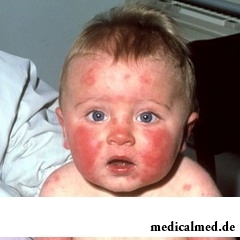 is not studied yet sufficiently though the main reasons and ways of infection are already revealed.
is not studied yet sufficiently though the main reasons and ways of infection are already revealed.
The infectious erythema is especially widespread among children though adults can also get sick. The disease belongs to respiratory infections as it is transferred in the airborne way.
The infectious erythema at children with the weakened immunity can testify to diseases of blood or existence of any chronic diseases.
Symptoms of an infectious erythema
The symptomatology of a disease can differ depending on various factors: age, existence of problems with system of blood, the accompanying pathologies, etc. The very first symptoms of an infection are respiratory signs which remind the early period of cold or flu. Body temperature increases, there is cold, an itch in a nose, sneezing, irritation and a pharyngalgia, a headache, a fever, a loss of appetite, the general weakness of an organism.
In several days on a body there is rash. At some patients rash is followed by the expressed weakness in muscles and joints. In clinical signs the infectious erythema is similar to different diseases therefore doctors often find it difficult to make the right diagnosis.
Often the disease is confused to other viral and microbic infections: roseola, clumsy rubella, scarlet fever, measles. Sometimes the infectious erythema can be confused with various allergic reactions to some medical supplies or contact dermatitis. With similar symptoms some diseases of connecting fabric proceed: system lupus erythematosus, pseudorheumatism, scleroderma.
The symptoms similar to catarrhal belong to the main manifestations of an infectious erythema. They arise later couple of days after impact of a virus on an organism. For the patient they often remain almost unnoticed. At the subclinical course of a disease rash can be short-term and then the patient does not realize at all that he was ill. The typical current is followed by pains in a stomach and the head, joint pains, temperature increase to 38 degrees, a febricula.
Rash is, as a rule, shown on a body for the fifth day since the moment a zarazheniyanetipichny current there can be an infectious erythema without rash.
Display of rash has a certain character and happens in several stages. Initially there are bright red rashes on cheeks. The person at the same time looks so as if child of an otkhlestala on cheeks. Sometimes the rash extends to a forehead and a chin. Similar rash keeps several days then completely disappears.
At the second stage the rash occurs in a trunk, a neck, on shoulders and forearms, buttocks, knees and in an upper part of shins. Externally rash looks as red round spots which expand afterwards in the form of "laces". Rashes are followed by an itch and keep on a body about a week then completely disappear. However, under the influence of the sun or a stress can appear on the same places again and not descend up to three weeks. Developing of repeated rash at all not necessarily speaks about an aggravation of symptoms.
Complications of an infectious erythema
The infectious erythema can cause various complications in children, but not always. First of all, for a disease synthesis of erythrocytes (red blood cells) can stop. As a rule, this complication at healthy people passes unnoticed and does not cause vital issues with a hemopoiesis.
If the patient already has problems with system of blood and erythrocytes in particular (a sickemia, a thalassemia), then it can provoke serious complications in system of blood. The temporary termination of development of erythrocytes can be shown in aplastic crisis lasting up to 7-10 days.
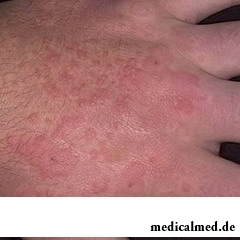 Even more dangerous the infectious erythema is for people with aplastic anemia. At these patients the disease is followed by apathy, fever attacks, a cardiopalmus and other unpleasant symptoms.
Even more dangerous the infectious erythema is for people with aplastic anemia. At these patients the disease is followed by apathy, fever attacks, a cardiopalmus and other unpleasant symptoms.
The infectious erythema at children with an immunodeficiency can develop into a chronic form that as a result will lead to development of serious defeat of a hemopoiesis and marrow with formation of persistent anemia.
Diagnosis of an infectious erythema
As it was already written earlier, laboratory and clinical diagnosis of this disease presents certain difficulties. As a rule, the infectious erythema can be assumed on availability of "laces", typical for rash.
For diagnosis of an infectious erythema it is necessary to carry out a number of laboratory analyses: serological inspections for identification of a number of antibodies to a virus, the general blood tests for determination of level of erythrocytes in blood. Also the quantity of thrombocytes and leukocytes as they also participate in process of a hemopoiesis is important and decrease together with red blood cells.
The general blood test gives also the chance to estimate efficiency of therapy and the beginning of the period of recovery.
Methods of treatment of an infectious erythema
At emergence of an infectious erythema at children and adults house treatment is shown. The principle of treatment same, as well as at all viral infections. For the period of fever it is necessary to observe a bed rest and to accept a large amount of liquid, and also symptomatic and antiviral drugs.
It is important to note that existence of the second and third wave of rash does not testify to weight of disease, and is its characteristic. For the period of a disease it is worth limiting reception of hot bathtubs, and also stay in the sun and in a sunbed as it provokes repeated rashes.
At treatment of an infectious erythema antibiotics are not appointed as this viral disease. However prescription of antibiotics is possible if quinsy, otitis, pneumonia or microbic complications joins a disease.
A certain danger is constituted by a disease during pregnancy, and also for people with diseases of blood or the weakened immunity. In that case treatment of an infectious erythema can be carried out in the conditions of a hospital under constant control of laboratory indicators and a hemopoiesis. To pregnant women in addition appoint ultrasonography of a condition of a fruit, and also the developed analyses to blood and coagulability.
No quarantine measures at treatment of an infectious erythema are taken as the patient from the moment of emergence of rash becomes absolutely not infectious therefore at good health can quite lead a usual life.
At present scientists actively develop a vaccine against the B19 virus therefore it is not excluded that vaccination against this disease will be carried out in the near future.
Scientists from the Oxford university conducted a number of researches during which they came to a conclusion that vegetarianism can be harmful to a human brain as leads to decrease in its weight. Therefore scientists recommend not to exclude completely from the diet fish and meat.

Bulimia and anorexia, are heavy deviations of a feeding behavior, become a cause of death of patients much more often than all others...
Section: Articles about health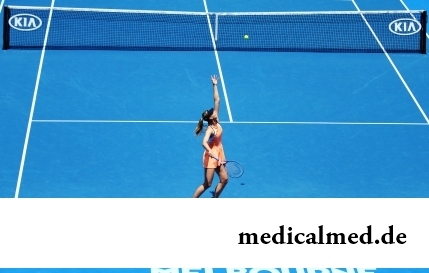
Proofs of efficiency of Mildronate at treatment of coronary heart disease with stenocardia can be found in many publications of the end of the twentieth century. Researches were conducted since 1984, including placebo - controlled effects. In total клиничес...
Section: Articles about health
Musicotherapy – a treatment method which caused and causes a set of a controversy concerning its efficiency. However the facts are relentless: during the numerous researches curative impact of music on an organism was scientifically confirmed. Since then in a number of the countries the technique is included complex therapy of diseases of cardiovascular and respiratory system, dorsodynias and a backbone, psychosomatic disturbances and many other illnesses. The musicotherapy in a pedi is especially widely applied...
Section: Articles about health
Olive oil – the product capable to make a powerful contribution to health of the person if it includes it in the diet. Rich vitamin...
Section: Articles about health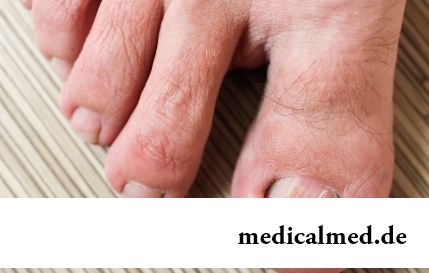
The word "onikhokriptoz" is unfamiliar to most of people, meanwhile quite so physicians call very widespread problem: the growing of edge of a nail into surrounding fabrics causing inflammatory process. Usually the illness affects thumbs of legs, and is followed покр...
Section: Articles about health
A lot of things depend on a condition of a backbone in a human body, a backbone - not only a support for a body, it also a receptacle for a spinal cord, that is why malfunctions with a backbone are so dangerous. To treat rachis diseases very difficult and long, it is much simpler and more correct not to bring to a disease. Conforming to the rules provided in this article it is possible to avoid the majority of the problems connected with a backbone including those which are considered to be age, but a cat...
Section: Articles about health
The brain of the person is studied not one hundred years, but the quantity of the riddles connected with this body increases rather, than reducing...
Section: Articles about health
Beauty shop – the place which is associated only with positive emotions: joy, pleasure, relaxation. However visit of salon where work with biological material of clients, not always harmlessly is conducted. Today it is known Bol...
Section: Articles about health
Today about 30 diseases, sexually transmitted are known. Wide circulation of these illnesses is extremely promoted by the dual attitude towards them: on the one hand, most of people know about "shameful" diseases very little and do not aim at receiving detailed and reliable information, considering that such problems personally will never concern them. With another – there are delusions about STD which instill unreasonable confidence that troubles such...
Section: Articles about health
The unpleasant feelings connected with spring breakdown are familiar almost to each of us. Often happens that in March-April on the person...
Section: Articles about health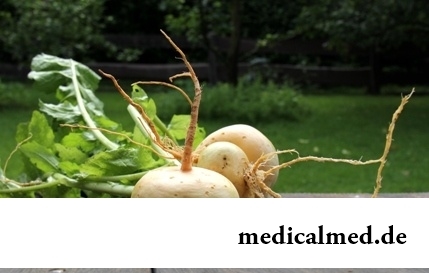
Turnip, radish, horse-radish – once these and other products enjoyed wide popularity at our ancestors, being not only the food sating an organism but also the medicines curing of many diseases. Unfortunately, having given the use of some of them...
Section: Articles about health
All diseases from nerves – in this joke a big element of truth, are said by doctors. Constant stresses lead to decrease in protective forces of an organism, and it becomes vulnerable for a set of diseases. It is wrong to think that the stress is a problem of the present. Life of people and hundred, and one thousand years ago also abounded with problems therefore need of a relaxation understood in ancient times – to some techniques more than one thousand years. The person needs knowledge of how it is possible to relax, this knowledge пригод...
Section: Articles about health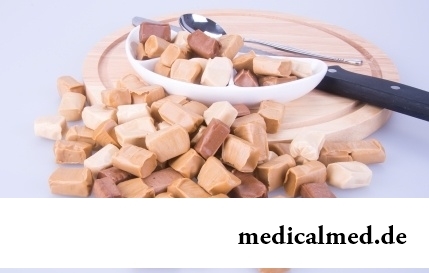
Food with the increased content of sugar is attractive to most of people - it is scientifically confirmed fact. Business here not in a nevozder...
Section: Articles about health
The fatigue, sleep debt, disturbances of food, bad mood, vagaries of the weather – all these circumstances badly affect our appearance. Especially the person suffers: skin becomes flabby, loses healthy color, becomes covered by wrinkles, zones of hypostases and t appear...
Section: Articles about health
Transfusion of donor blood has almost century history. In spite of the fact that this procedure is quite usual for many people, process of blood donation is still surrounded with numerous myths. Today we aimed to discredit the most widespread of them....
Section: Articles about health
All are familiar with cold, and practically everyone believes that he has sufficient knowledge and experience that correctly to treat it. N...
Section: Articles about health
It is difficult to revaluate importance of kidneys for an organism. These bodies not only perform work on purification of blood of decomposition products and removal of excess liquid. They are responsible also for production of some hormones necessary for normality maintenance...
Section: Articles about health
All know that self-treatment is dangerous. However absolutely it is almost impossible to do without it. Rate of modern life does not allow to handle each small trouble to the doctor and information on ways of independent delivery of health care is quite available. Means, all of us have only one: to learn to give this help competently and in those limits in which it is possible for the person who does not have vocational education....
Section: Articles about health
A little more than a century ago goat milk was a traditional food stuff of most of Russians. Unfortunately, today on tables...
Section: Articles about health
Antibiotics - - it is possible to call the chemical compounds suppressing growth of bacteria the break in the field of medicine which allowed to save mankind from many diseases incurable earlier: tuberculosis, plague, syphilis and many others. A contribution of drugs to rescue of people from...
Section: Articles about health
Subfebrile temperature call fervescence to 38 degrees, and subfebrile condition - existence of such temperature over 3 days, and quite often it happens without the visible reasons. Existence of subfebrile condition - a strong indication of disturbances in an organism which can be caused by various reasons: disease, stresses, hormonal failures. Despite the seeming inoffensiveness it is a state at which people often continue to lead a usual life, often is a sign of many of a zabolev...
Section: Articles about health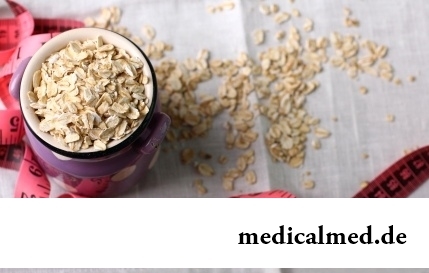
The list of stereotypes of which, apparently, all know strongly includes following: British surely eat for breakfast овсянк...
Section: Articles about health
Residents of big cities quite often have a disease which is known as the syndrome of chronic fatigue (SCF) today. This illness affects the people belonging to various social and demographic groups and living on all continents. Most of all SHU to a podverzha...
Section: Articles about health
Eyes – unique body on the structure thanks to which the person obtains about 80% of information on the world around: about a form, color, size, the movement, and also many other parameters of objects or phenomena. But whether much we know about the most valuable sense body which, according to the scientist Sechenov, provides us about one thousand various feelings a minute? Let's consider 10 most surprising facts about eyes and sight....
Section: Articles about health
For most of the working people the problem of having a snack is particularly acute enough. Sooner or later there is a question: what is possible quickly for a sja...
Section: Articles about health
Partial and the more so full loss of hearing significantly reduces quality of life. Difficulties with communication lead to loneliness and isolation. The person who badly hears experiences difficulties with social and professional implementation, quite often has problems in...
Section: Articles about health
The advantage of swimming for the person is so high that this sport is not only the most popular, but also is widely applied in medicine and rehabilitation processes. If you look for for yourself the occupation allowing pleasantly and to spend time, then swimming with advantage – the fact that it is necessary for you. And give learns several facts about swimming....
Section: Slideshow
